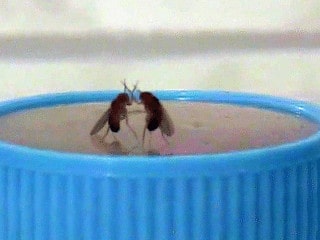What brings out the beast in a fruit fly?
When Dr. Herman Dierick, assistant professor of molecular and human genetics at Baylor College of Medicine and his colleagues sought an answer to that question, they decided to look at transcription factors and particularly those that are “conserved” throughout evolution – in this case from flies (Drosophila melanogaster) to mice.
(Transcription factors are proteins that bind to DNA and either block or promote the enzyme that controls the reading, or “transcription,” of genes, making them more or less active.)
In a report that appears online in the journal Nature Communications, Dierick and his colleagues studied a transcription factor called tailless that is similar to one called NR2E1 in mice. The mouse factor is already associated with aggression and brain developmental defects, but would that prove true in flies?
Aggressive flies
The problem with tailless is that it is a crucial factor in the development of flies at the earliest period. When it is mutated, the fly embryos die. However, Dierick and his colleagues used a technique RNA interference to mutate or “knockdown” the factor in only the neurons of the adult flies. That meant that the protein associated with the gene was present in lower levels than normal.
“When we do that, the flies are viable and have increased aggression. Their brains look normal,” said Dierick. When they did the same thing in adults, the adults became aggressive but again, their brains looked normal. That probably means that the gene tailless is not involved in development but instead affects adult function.
Knockdown vs. rescue
They found that the gene was most active in a part of the fly brain called the pars intercerebralis, which has some similarity to the hypothalamus in humans. The hypothalamus is associated with aggression in humans. If the gene was “knocked down” only in the cells of the pars intercerebralis, they saw aggression again. However, if they attempted to correct the deficit (so-called rescue in genetic terms) with a human gene, they were successful.
When they did a similar knockdown of Atrophin, a co-repressor of tailless, they found flies were also aggressive. Both the Atrophin and tailless proteins physically interact in the pars intercerebralis. Curiously, a poly-Q expansion of one of the two mouse atrophins causes a neurodegenerative disease that is also characterized by increased aggression. (A poly-Q expansion refers to an abnormal number of repeats of the bases cytosine, adenine and guanine [CAG] in the genetic code. Large numbers of repeats result in a mutant protein that can cause disease.)
“Mechanistically, knocking down tailless or Atrophin affects the production and or release of neuropeptides in the pars intercerebralis,” said Dierick.
Aggression regulation
As a result, he and his colleagues propose that there is a transcriptional neuronal control “module” in Drosophila that governs aggressive behavior, although the mechanistic links between all these components –tailless, atrophin and neuroptide release from neurosecretory cells – have not yet been made in mice.
Dierick theorizes that this module is conserved in evolution. It is an ancient and conserved mechanism that involves aggression regulation.
Others who took part in this work include Shaun M. Davis, Amanda L. Thomas, Krystle J. Nomie and Longwen Huang, all of Baylor.
Funding for this work came from the Burroughs Wellcome Fund—the Houston Laboratory and Population Science Training Program in Gene–Environment Interaction of The University of Texas Health Science Center at Houston (BWF Grant No.
1008200), the Naman Family Fund for Junior Faculty at BCM and the National Science Foundation (Grant IOS-1119473).


